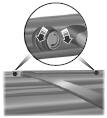Roof racks and load carriers
WARNING: When loading the roof rail crossbars, it is recommended to evenly distribute the load, as well as maintain a low center of gravity. Loaded vehicles, with higher centers of gravity, may handle differently than unloaded vehicles. Extra precautions, such as slower speeds and increased stopping distance, should be taken when driving a heavily loaded vehicle.
Note: The maximum recommended load is 100 pounds (45 kilograms), evenly distributed on the crossbars.
Note: Loads should never be placed directly on the roof panel. The roof panel is not designed to directly carry a load.
For proper function of the roof rack system, loads must be placed directly on crossbars affixed to the roof rack side rails. Your vehicle may be equipped with factory-installed crossbars. Ford Genuine Accessory crossbars, designed specifically for your vehicle, are also recommended for use with your roof rack system.
Make sure that the load is securely fastened. Check the tightness of the load before driving and at each fuel stop.
Adjusting the Crossbars (If Equipped)
Note: Wind noise can be minimized by either removing or repositioning the crossbars when they are not is use. Position the rear crossbar fully rearward and the front crossbar 10 inches (25 centimeters) from the front end-cap.

1. Loosen the tie-down hooks at both sides of the crossbar by turning them counterclockwise.
A small screwdriver or similar tool can be used to break the torque by inserting
the shaft into the tie-down hook and twisting.
2. Slide the crossbar to the desired position. This may require someone on each
side of the crossbar.
3. Tighten the tie-down hooks at both sides of the crossbar by turning them clockwise
until tight.A small screwdriver or similar tool can be used to tighten the hook
an additional half turn.
Make sure to check that the tie-down hooks are tight each time a load is added or removed from the roof rack, and periodically while traveling.
Make sure that the load is secure before traveling.
See also:
Windows and Mirrors
Power windows
WARNING: Do not leave children unattended in your vehicle and do not let
children play with the power windows. They may seriously injure themselves.
WARNING: When closing the power ...
Instrument lighting dimmer
Press repeatedly or press and hold until the desired level is reached.
Note: In the uplevel message center only, a message will pop up that will
show incrementally where the dimmer is in relation ...
Data Recording
Service Data Recording
Service data recorders in your vehicle are capable of collecting and storing
diagnostic information about your vehicle. This potentially includes information
about the perf ...
